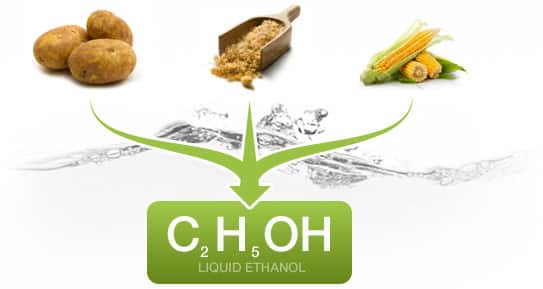Biofuel is a form of recycled fuel, produced from biomass or waste generated by the use of organic material which may be any substance including vegetable and animal products like grass, trees, plant parts and plants in the ocean.
Biomass can produce liquid and gaseous fuels, which can do almost everything that fossil fuels do. It can be converted into useful forms of energy like methane gas or transportation fuels. It is a fuel composed of a recently dead biological matter. Biofuel and fossil fuels are different as fossil fuels are made up of long dead organic matter, whereas, biofuels are made up of recently dead matter. Biofuels contain 80% renewable materials.
Plants that photosynthesize produce the organic material making biofuels. The specific biofuel made by corn is Ethanol (ethyl alcohol), biofuel  made by soybeans is biodiesel, and others are classified as biomass.
made by soybeans is biodiesel, and others are classified as biomass.
Biofuels are known as argofuel, also. This type of fuel has been gaining more attention since there has been a sharp depletion in fossil fuel resources, increase in their price and their negative effects in the form of greenhouse gas emissions. Need for energy security further justifies search for biofuels.
Most vehicles on the road today are fueled by gasoline and diesel fuels. These fuels are produced from oil, which is a non-renewable fossil fuel. Non-renewable fuels depend on resources that will eventually run out. Renewable resources, in contrast, are constantly replenished and will never run out. Biomass is one type of renewable resource, which includes plants and organic wastes.
What are the general techniques involved in the production of biofuel? (Brief Information)
For ethanol, Brazil and the USA are the largest producers but strong production growth is foreseen in China, India, Thailand and several African countries. Biodiesel production is dominated by the EU but a significant growth is expected in Brazil, Indonesia and Malaysia.
There are two methods currently brought into use to for production of biofuels. In the first one, sugar crops or starch are grown and through the process of fermentation, ethanol is produced. In the second method, plants are grown that naturally produce oil like jatropha and algae. These oils are heated to reduce their viscosity after which they are directly used as fuel for diesel engines. This oil can be further treated to produce biodiesel, which can be used for various purposes.
Biomass can be termed as material, which is derived from recently living organism. Most of the biomass is obtained from plants and animals and include their byproducts. Some agricultural products specially grown for the production of biofuels are switch grass, soybeans and corn (in United States), sugar cane (in Brazil), sugar beet and wheat (in Europe) cassava and sorghum (in China), miscanthus and palm oil (in Southeast Asia) and jatropha (in India).
Bioethanol
Bioethanol is an alcohol made by fermenting the sugar components of biomass. Today, it is made mostly from sugar and starch crops. With  advanced technology being developed by the Biomass Program, cellulosic biomass, like trees and grasses, are also used as feed-stocks for ethanol production. Ethanol can be used as a fuel for cars in its pure form, but it is usually used as a gasoline additive to increase octane and improve vehicle emissions.
advanced technology being developed by the Biomass Program, cellulosic biomass, like trees and grasses, are also used as feed-stocks for ethanol production. Ethanol can be used as a fuel for cars in its pure form, but it is usually used as a gasoline additive to increase octane and improve vehicle emissions.
Biomass is material that comes from plants. Plants use the light energy from the sun to convert water and carbon dioxide to sugars that can be stored, through a process called photosynthesis. Organic waste is also considered to be biomass, because it began as plant matter.
Bioethanol Production
Two reactions are key to understanding how biomass is converted to bioethanol:
- Hydrolysis is the chemical reaction that converts the complex polysaccharides in the raw feedstock to simple sugars. In the biomass-to-bioethanol process, acids and enzymes are used to catalyze this reaction.
- Fermentation is a series of chemical reactions that convert sugars to ethanol. The fermentation reaction is caused by yeast or bacteria, which feed on the sugars. Ethanol and carbon dioxide are produced as the sugar is consumed. The simplified fermentation reaction equation for the 6-carbon sugar, glucose, is:
| C6H12O6 —> 2 CH3CH2OH + 2 CO2 |
| Glucose Ethanol Carbon dioxide |
Biodiesel
Biodiesel is a mixture of fatty acid alkyl esters made from vegetable oils, animal fats or recycled greases. Biodiesel can be used as a fuel for vehicles in its pure form, but it is usually used as a petroleum diesel additive to reduce levels of particulates, carbon monoxide, hydrocarbons and air toxics from diesel-powered vehicles.
Biodiesel Feedstocks
In the United States, most biodiesel is made from soybean oil or recycled cooking oils. Animals fats, other vegetable oils, and other recycled oils can also be used to produce biodiesel, depending on their costs and availability. In the future, blends of all kinds of fats and oils may be used to produce biodiesel.
Biodiesel Production
The main reaction for converting oil to biodiesel is called trans-esterification. The trans-esterification process reacts an alcohol (like methanol) with the triglyceride oils contained in vegetable oils, animal fats, or recycled greases, forming fatty acid alkyl esters (biodiesel) and glycerin. The reaction requires heat and a strong base catalyst, such as sodium hydroxide or potassium hydroxide. The simplified trans-esterification reaction is shown below.
Base
|
Triglycerides + Free Fatty Acids (<4%) + Alcohol ——> Alkyl esters + glycerin |
Acid
|
Triglycerides + Free Fatty Acids (>4%) + Alcohol ——> Alkyl esters + triglycerides |
What are the advantages, disadvantages and limitations of these fuels in the society?
Wood has been used since very early times and is one of the major contributors of global warming.
How will biofuel production affect food security and poverty?
Food prices have risen sharply in the past few years, especially for cereals and vegetable oils, in part because they are used both for food and biofuel production. In addition, higher transport costs increased the costs of imported food. While some countries will benefit from higher food prices, the food bill is expected to increase for the least-developed countries, which are net food importers.
The effect of a price increase will be significant for the estimated 850 million people around the world who are undernourished, most of whom are net buyers of food, both in urban and rural areas.
In the longer term, biofuel production could revitalize the agriculture sector and alleviate poverty by raising rural incomes. But, government support for improved infrastructure, institutions and services remains essential, for instance to improve farmers’ access to credit.
While production of crops for biofuel production may offer opportunities for farmers in developing countries, it may also lead to greater competition for land. Those most at risk are small farmers and especially women, who usually do not own the land that they farm. Strong government commitment is needed to improve agricultural productivity and assure equal opportunities and access to both land and markets.
Expanded biofuel production may threaten land and water resources and biodiversity. Appropriate policy measures are required to minimize possible negative effects.
Some countries with abundant natural resources and appropriate infrastructure and institutions may be able to develop an economically viable biofuel sector. However, liquid biofuels will only be able to make a limited contribution to the global supply of transport fuels.
Biofuel growth has thus far been driven primarily by policies rather than market forces. Policies must be reviewed to avoid negative impacts and promote sustainable biofuel production.
One problem could be that crops grown solely for turning into biofuel will, as mankind is basically greedy, especially for money, mean the clearing of even more areas of rain-forests for growing biofuel crops, and present-day agricultural farms no longer growing food crops.
The raw material accounts for the largest share of total biofuel costs. Over the past few years, prices of raw materials for biofuel production have been highest when crude oil prices were high. Biofuel policies themselves have contributed to increased demand for agricultural products and thus increased prices. However, high crude oil prices and government subsidies also enable biofuel producers to pay higher prices while still remaining profitable.
